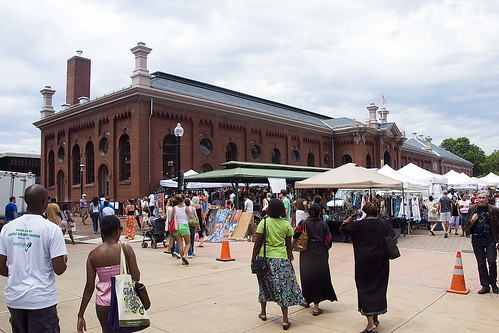Preservation and development "almost inseparable": DC's economic planning
Last week, the press reported ("City Swears It'll Actually Implement An Economic Development Planfrom the Washington City Paper) on an economic development conference convened by the Executive Branch of the city, as part of a process to develop a well balanced economic development plan for the city. From the press release:
The Five-‐Year Economic Development Strategy will be formulated via a Strategy Advisory Group. Advisory group members include D.C. Council Chairman Kwame R. Brown, other elected officials, District government agency directors, university presidents, and leading employers in each target sector. The group will be overseen by staff from the Office of the Deputy Mayor for Planning and Economic Development (including Deputy Mayor Hoskins and Director of Business Development David Zipper) along with business school deans Doug Guthrie of The George Washington University and Dave Thomas of Georgetown University, plus a lead consultant from McKinsey and Company. Another project consultant will also shepherd the work of the business school students along with their respective academic staff.
The seven industry sectors represented in the Strategy Advisory Group are:
• Federal Government and Federal Government Contractors
• Higher Education and Health Care
• Hospitality
• Professional Services
• Real Estate and Construction
• Retail
• Technology
• Public Sector
Of course, this is long overdue. I lament about the lack of a strategic or vision plan all the time (e.g., see this past entry, "Unstrategy for economic development in DC").
But it's not clear to me that the crew picked for this important effort has the broad range of experiences and approaches necessary to produce a truly stellar, deep, and wide plan.
E.g., just in the context of a commercial district revitalization framework plan I did for Cambridge, Maryland, on the creative rural economy initiative in Prince Edward County, Ontario. This was the general approach taken by the city Office of Planning and the Washington DC Economic Partnership last year, when they produced a draft plan in association with a grant proposal to the Department of Commerce. While I didn't read all of that plan, it was surprisingly honest and critically analytical of DC's economic position.
But the articles I read concerned me, because I still don't think that most of the movers and shakers in the city understand the fundamentals of the city's economic-competitive advantage as a place to do business, locate business, live, work, or be entertained.
DC-based historic preservation economic consultant Donovan Rypkema (his website, Place Economics, has links to many reports he has authored on the topic, read a couple and you'll know a lot more than you do right now) spoke in Milwaukee last week about the inextricable connection between historic preservation and urban economic development and revitalization, which was written about in the Milwaukee Business Journal, "Consultant tells Milwaukee to marry preservation and development."
It reminds me of how I am meaning to find out more about DC's economic development planning process. I wonder how much the people picked will consider preservation and history (as well as transportation) in the creation of this plan.
They are:
------
For the preparation of the Comprehensive Plan update (2005-2006), the city commissioned a number of think papers on various topics relevant to the plan. Don Rypkema wrote the one on historic preservation, "Planning the Future, Using the Past (Historic Preservation)," which every civic activist in the city should read.
Also, I discussed what I call the nexus of preservation as "architecture, place, and history" in this 2005 entry, "Who can you turn to when the most active, aggressive destroyers of the city's livable places are DC Government agencies?"
Labels: economic development, Growth Machine, historic preservation, real estate development, transit, transportation planning, urban design/placemaking, urban revitalization




0 Comments:
Post a Comment
<< Home